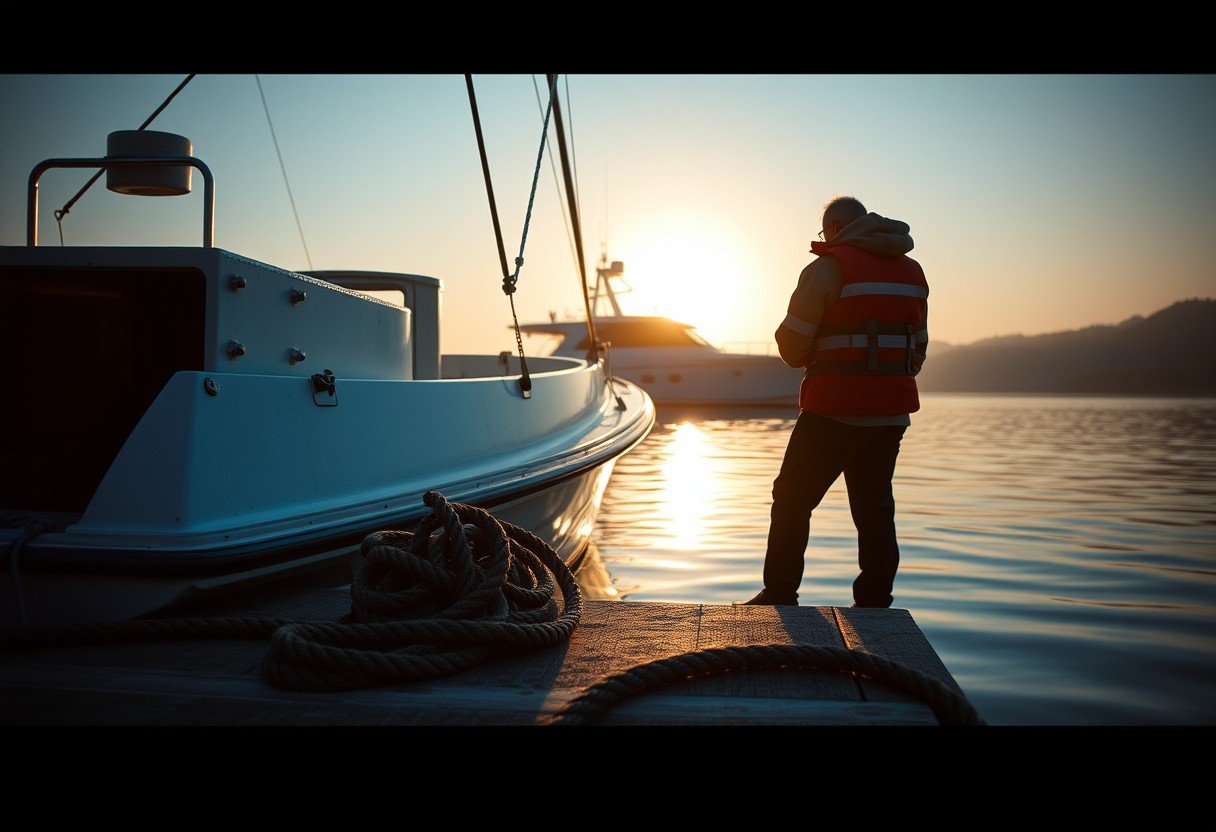Most boaters are eager to get moving, but the moments while your engine warms up are critical for safety. Using this time for a pre-departure check ensures your vessel is ready, your crew is prepared, and your journey starts smoothly. This essential routine helps you spot potential problems on the dock, not out on the open water, guaranteeing a safer and more enjoyable experience for everyone on board.
Prioritizing Safety Before You Untie the Lines
The most important task before casting off is a thorough safety check. This isn’t just about compliance; it’s about being prepared for unexpected situations. A few minutes spent here can make all the difference in an emergency.
Verifying that all safety gear is on board and in good condition is non-negotiable. This includes ensuring you have enough life jackets for every person, that they are easily accessible, and that they are the correct size.
Check your visual distress signals, like flares, to ensure they are not expired. Also, confirm your fire extinguishers are fully charged and located where they can be reached quickly. A well-stocked first-aid kit is another crucial component of your safety arsenal.
Essential Equipment Checks for a Worry-Free Trip
While the engine idles, it’s the perfect time to run through your boat’s critical systems. A mechanical failure on the water can quickly escalate from an inconvenience to a dangerous situation.
Start by checking your engine fluids, including oil and coolant levels. Look for any leaks in the engine compartment. Test your navigation lights, even during the day, as you never know if your trip might extend into the evening.
A quick operational check of other key systems will build confidence for your trip ahead.
- Bilge Pump: Manually activate the bilge pump to ensure it turns on and effectively pumps water.
- Steering System: Turn the wheel from lock to lock to confirm smooth and responsive steering.
- Throttle and Shifter: With the engine idling, briefly engage forward and reverse to ensure the transmission is working correctly.
Finally, ensure your battery connections are tight and free of corrosion. A secure connection is vital for keeping your engine and electronics running reliably throughout your journey.
Securing Your Vessel and Assessing the Area
Before you release any lines, take a moment to secure everything on the boat. Loose items on deck can become dangerous projectiles when the boat starts moving or encounters a wake. Stow away coolers, bags, and any other gear to keep the deck clear.
This is also the time to assess your immediate surroundings. Look for other boat traffic, swimmers, or obstacles near the dock. Pay close attention to wind and current, as they will affect how your boat handles as you pull away. A clear understanding of these factors allows for a clean and controlled departure.
Navigational Prep While the Engine Warms
Don’t wait until you’re in open water to think about your route. While the engine reaches its operating temperature, review your planned course.
Check the latest weather forecast for any changes in wind, waves, or potential storms. A quick look can prevent you from heading into unsafe conditions.
Power up your GPS or chartplotter and review your departure route from the marina or dock. Identify any shallow spots, buoys, or heavy traffic zones you’ll need to navigate. Having this fresh in your mind makes for a much smoother and less stressful exit.
Communicating Your Departure Plan
A successful departure is a team effort. Ensure everyone on board, whether they are experienced crew or guests, understands the plan.
Brief your crew on their roles for casting off. Let them know which lines will be released and in what order. Clear and simple communication prevents confusion and mistakes. It’s also vital to announce when you are starting the engine and when you are about to leave the dock, so no one is caught by surprise.
If you are in a busy marina, a quick call to the dockmaster on the VHF radio is a good practice to announce your departure. This courtesy alerts them and other nearby vessels of your movements.
The Final Pre-Departure Checklist
A final walkthrough ensures nothing has been overlooked. This is your last chance to catch a small issue before it becomes a big problem. A systematic check is the best way to guarantee you are ready.
This simple checklist can be performed in just a couple of minutes and provides excellent peace of mind.
| Item to Check | Status | Notes |
|---|---|---|
| Fuel and Water Levels | Sufficient for Trip | Remember the 1/3 rule: 1/3 out, 1/3 back, 1/3 reserve. |
| Dock Lines and Fenders | Ready for Release/Stowage | Ensure lines are not tangled and fenders are ready to be brought in. |
| Engine Gauges | Normal Operating Range | Temperature and oil pressure are stable. |
Once these final checks are complete, and you’ve communicated with your crew, you are ready to cast off confidently.
Frequently Asked Questions
What is the first thing I should do before starting the engine?
Before starting the engine, you should always perform a quick visual inspection of the engine compartment and check your fluid levels. It’s also wise to inspect mooring lines to ensure they are clear of the propeller.
How long should I let my boat engine warm up?
Most marine engines only need a few minutes to warm up at idle. You should allow enough time for the engine temperature to rise to its normal operating range and for oil to circulate properly before putting it under load.
Is it necessary to check the weather even for a short trip?
Absolutely. Weather conditions on the water can change very quickly. A quick check of the forecast helps you prepare for wind or waves and can prevent you from getting caught in a dangerous storm.
What should I tell my guests before leaving the dock?
Give your guests a brief safety orientation. Show them where life jackets are located, point out safety equipment like fire extinguishers, and explain basic rules, such as keeping hands and feet inside the boat during docking and departure.
Why is it important to check my surroundings before casting off?
Checking your surroundings helps you account for wind, currents, and other boat traffic. This awareness allows you to plan your departure maneuver safely, preventing potential collisions with the dock, other vessels, or underwater hazards.









Leave a Comment